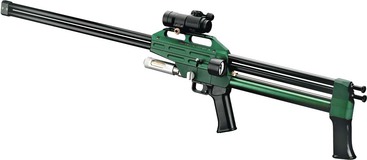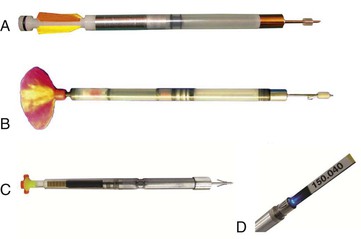Chris Walzer, Hanno Gerritsmann The first description of a “flying syringe,” which used an acid–base reaction to administer drugs to animals from a propelled aluminum dart, was published in 1958.4 Unfortunately, this ingenious idea has remained largely unchanged over the past 55 years, and most new developments are mere refinements of this original concept. Since field capture of wild animals may cost a large amount of money per animal, in terms of personnel and transport costs, remote injection systems need to be efficient and reliable.10 Precision is of major importance as, in the field, usually only one chance is available to hit the animal. After the initial firing noise, the animal usually flees. Furthermore, the preferred target area on an animal may only be a few square centimeters (cm2) in small animals. If imprecise remote injection systems are used, the shot may be misplaced, wounding or killing the animal or missing the animal entirely.11 The risk of severe tissue disruption, including hemorrhage, necrosis, and bone fractures, increases when using pressure-driven injection systems, which strike the animal with high-impact energy. A thorough understanding of the equipment and the anesthetics employed, in conjunction with professional training in wildlife chemical immobilization, are important to prevent accidents. Since it is hard to approach free-ranging animals, remote injection systems need to be able to hit the animal over long distances without wounding the individual. Especially for the capture of free-ranging wildlife, the available products on the market are unsatisfactory in their performance with respect to range, accuracy, and precision. Because of the inherent constraints engendered by the necessarily lightweight darts and acceptable impact energy, it appears unlikely that novel solutions will markedly improve on the future performance of today’s projector. A rise in animal welfare awareness and concerns has given rise to the clear trend in the past decade toward compressed gas projectors, which allow for the continuous adjustment of pressure according to target distance. In general, higher pressures result in a faster dart that flies further. However, wind resistance places limitations on this by rapidly slowing the dart. Darts propelled by carbon dioxide (CO2) projectors usually travel at about 40 to 60 meters per second (m/s). In contrast, cartridge-propelled darts fired from extra-long range projectors have been measured to have mean impact velocities of up to 113 m/s.2,19 The manufacturers’ recommendations are, at best, only a guide, and the users of remote injection systems must individually calibrate their rifle or dart combinations by finding the best pressure settings. With regard to the effective shooting range, a significant disparity exists between the technical specifications and the results in the field. In a study on dart gun range and precision, none of three remote injection systems, apart from the Pneu-Dart X-Caliber (Pneu-Dart Inc., Williamsport, PA), attained the effective shooting range specified by the manufacturers. In this study, a correlation was observed between a stable dart trajectory and the pressure setting of the rifle. Trajectories remained stable up to a certain, rifle-specific, pressure. When this pressure was exceeded, the dart trajectory became unstable.5 The different calibers offered currently make dart guns less user friendly. Manufacturers offer dart guns with interchangeable barrels, but changing barrels is time consuming, as the user needs to “sight” in the new barrel before use. Developments in the field include a double-barrel dart gun, the JM.DB (Figure 79-1) made by Dan-Inject (DAN-INJECT ApS, Børkop, Denmark) featuring either two identical barrels or an 11-mm barrel and a 13-mm barrel, which alleviates the caliber problem, as the gun is capable of propelling virtually all darts available for CO2 guns. In remote, open-range situations where helicopters are not readily available for capture of animals, veterinarians regularly find themselves frustrated by large flight distances exceeding 1 kilometer (km) or more. To address this problem, stationary, remote-controlled, video-enabled dart guns have been used at waterholes or feeding sites.17, 21 Recent advances in the field include lighter 5-milliliter (mL) 11-mm Ø slow air injection darts that may be used in the standard 11-mm barrels. This greatly simplifies the use of these larger volume darts. Several producers now have very-high-frequency (VHF) transmitters available to facilitate tracking and recovery of the darted animal (TeleDart GmbH & Co. KG, Westheim, Germany; Dist-Inject International, Basel, Switzerland; DanWild LLC, Austin, TX) (Figure 79-2). Pneu-Dart, Inc. now offers VHF transmitters that have an extended range of operation for their 13-mm rapid-injection darts. These transmitters have been tested under steppe–desert field conditions, where a signal may be received up to a distance of 1000 meters (m). However, if the animal becomes recumbent on the transmitter dart, the maximum range is halved. Additionally, these transmitters may be supplemented with flashing LEDs (light-emitting diodes) on the tailpiece for night visibility (see Figure 79-2, D). This feature has proven useful when shooting in darkness to determine a hit. A prototype for remote application of passive identification transponders based on a Pneu-Dart model dart was recently shown to offer new opportunities in this regard.20 Additionally, Pneu-Dart now offers gun-mounted LEDs to illuminate the barometer, which is also extremely helpful when working during the night (Dial face illuminator, Pneu-Dart, Inc. Williamsport, PA).
Update on Remote Delivery and Restraint Equipment
History and Background
What’s New
Darts
![]()
Stay updated, free articles. Join our Telegram channel

Full access? Get Clinical Tree


Update on Remote Delivery and Restraint Equipment
Chapter 79


